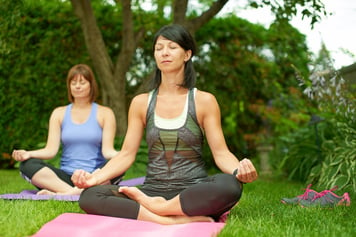Have you ever felt like you are experiencing with anxiety or a sense of fear through your day? This could feel like being “on edge,” having an uneasy stomach, tension in your body or an overall sense of discomfort and worry.
You’ll be relieved (and even surprised) to hear that through everything that is happening, we have the power to CHOOSE to be calm. Going from a state of heightened emotions to a balanced and grounded place is called emotional regulation. Let’s talk about what emotional regulation is and how we can use it in our lives.
Emotional Regulation.
Emotional regulation is the ability to control one’s own emotional state. This can help us be more adaptable to the environment around us and can lead to healthier thoughts, attitude, mood and behaviors.
Let’s take Matt for example: Matt is having a difficult morning. The kids struggle to settle for virtual school, he burns the breakfast toast and right as he opens his laptop for work … he spills his coffee on himself. Ouch.
This would cause anyone to feel frustrated and stressed. With limited emotional regulation, Matt may continue to be frazzled, unable to think clearly. He may focus on the stress of the morning throughout his day.
Instead, with the use of emotional regulation skills, Matt can recognize his stress response, engages in calming his nervous system, focuses on emotionally grounding thoughts and moves forward with his day. He may even pour himself a new cup of coffee.
Healthy emotional regulation can help people like Matt not be overtaken by stressful circumstances and be present in their lives. When we utilize emotional regulation skills, we are able to live more happier lives and feel more patience, joy and even creativity.
Below you’ll find a few strategies to try out and put into your own “emotional regulation toolbox.”
5 Emotional Regulation Strategies to Try.
Choose: Apply your power of choice.
You have the choice of how you react to situations. When you engage your power of choice, you begin to control how your mood, emotions, behaviors and life will be impacted by factors around you. Practicing choice is an important skill for emotional regulation.
STOP.
This is a technique designed by Carol Vivyan. If you are struggling to get your emotions under control, this technique is a great process to follow to manage your emotions more effectively:
- S – Stop
- T – Take A Breath
- O – Observe – your thoughts and feelings
- P – Pull Back – put in some perspective – what is the bigger picture?
- P – Practice What Works – Proceed – what is the best thing to do right now?
Don’t Judge Your Emotions.
Emotions are often named as “good” or “bad.” This can lead to judging your emotions instead of recognizing and honoring them. Instead, try to explore whether your emotions are depleting or renewing.
Depleting emotions like fear, frustration and anger can increase tension and prolong the short-term stress response in your body. Renewing emotions, like grace, compassion and courage can regenerate your system and improve your energy and mood.
Practice Challenging and Reframing.
Reframing is helpful to counterbalance the negative self-talk that happens in your mind every day. We naturally lean towards negative self-talk, especially in moments of high stress and anxiety. The negative self-talk can dampen our mood and take us out of the present moment.
We don’t have to let it!
Remember that the negative self-talk does mean it's the truth. Take the time to challenge it and search for evidence that will prove your negative narrative as untrue. Then develop a narrative that is more truthful and renewing to your wellbeing.
Use Your Breath.
When we experience unpleasant emotions, we start to breathe faster, our heart rate increases and we can feel a range of responses in our body. Deep breathing helps calm down the body by controlling our immediate reactions. This can can help calm our mind. When our body and mind are in more calm states, we are able to have more helpful thoughts and renewing emotions. Here are a few simple steps on how to breathe deeply:
- Inhale slowly through your nose until you can’t take in any more air
- Your stomach should expand. If you’re lying down, place your hand on your belly and you’ll feel it rise.
- Exhale slowly and completely through your mouth. Make sure you gently exhale, like you would if you were blowing on hot food.
With so much happening in our world, it is easy to feel a loss of control. Although we may be limited to changing the situations that impact us, we have complete control of changing our thoughts and feelings. Remember that emotional regulation skills are learned over time by practicing. So be gentle with yourself and know that even in the most stressful moments, you have the power to choose to be calm.
.png?width=1650&height=1275&name=website%20images%20(30).png)
Table of contents



